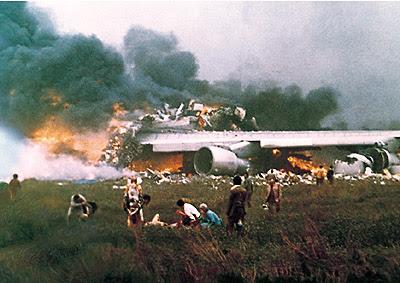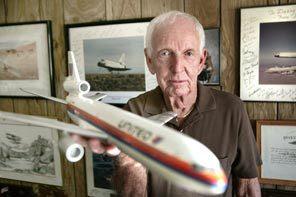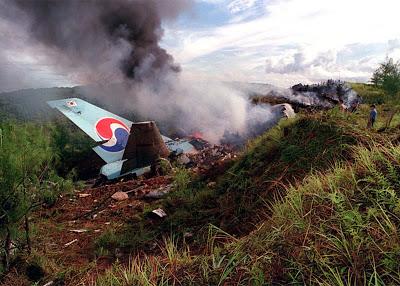Citing the 1977 collision of two Boeing 747s in thick fog at Tenerife, a 1979 study by NASA found human error to be the cause for most all aviation accidents and in 1981, United Airlines became the first airline to teach CRM techniques to its pilots. Crew Resource Management is now industry standard for the airlines and has also been adopted in industries like fire-fighting and heath care where leadership, effective communication and decision making skills are critical.

March 27, 1977 / Tenerife
There's a hierarchical relationship between the captain and first officer that is both necessary and in some cases...potentially dangerous. It's important for someone to be in charge because the pilots aren't always going to agree and someone has to have the final word. But an effective captain will foster an atmosphere in the cockpit that encourages interaction and stresses the importance of speaking up when something isn't right.It should come as no surprise that some captains are better at this than others. I have flown with captains who make it clear from the first hand shake that my experience and opinion are both needed and appreciated. My input is encouraged, my thoughts are considered, and my value as a member of the crew is made clear…I find it especially easy to excel in this environment. Not only do I feel like a valued member of the crew, but I'm more comfortable in general with my role as the first officer. The result is that the product of my efforts...everything from pre-flights to landings...are better when I'm flying with a captain who understands the value of good CRM.

An example of CRM done right. Captain Al Haynes from United 232.
United 232 was a scheduled flight from Stapleton International Airport in Denver, Colorado to O'Hare International Airport in Chicago, with continuing service to Philadelphia International Airport. Flight 232 crash-landed in Sioux City, Iowa on July 19, 1989 after suffering a catastrophic failure of its tail-mounted engine and the loss of all flight controls. Of the 296 people on board, 111 died in the accident while 185 survived. Even though there was significant loss of life, the accident is considered a prime example of successful Crew Resource Management due to the manner in which the flight crew handled the emergency and the high number of survivors considering that the airplane was landed without conventional flight controls. It should also come as no surprise that pilots from some countries are better at CRM than others. In some cultures, societal teachings emphasize that a person is NEVER to challenge authority. In spite of airline flight training that heavily emphasizes CRM techniques, that mind set still exists today. You just can’t change 3000 years of culture.
CRM gone wrong. The crash of Korean 801 in Guam, 1997.
Korean Air 801 departed Seoul, South Korea on August 5, 1997 on its way to Guam. On board were two pilots, a flight engineer, 14 flight attendants, and 237 passengers…a total of 254 people. There was heavy rain at Guam so visibility was significantly reduced and the crew attempted an instrument landing, but the glideslope portion of the Instrument Landing System (ILS) for runway 6L was out of service. However, the captain believed the glideslope was functioning and managed to pick up a signal which was later identified to be from an irrelevant electronics device on the ground. The crew noticed that the aircraft was descending very steeply, and noted several times that the airport was "not in sight". Despite protests from the flight engineer that the detected signal was not the glide-slope indicator, the captain pressed on…the aircraft impacted a hill about 3 nautical miles short of the runway at an altitude of 660 feet. Hierarchical stratification of Korean society and authority is considered a factor in why concerns about a failed approach were not heeded by the captain.My way or the highway...
Obviously, the captain is in charge. The airplane is his...the cockpit is his....he is responsible for the airplane, crew members (pilots and flight attendants), passengers and cargo, and his number one role is the safe operation of the flight. A good captain recognizes the importance of an involved crew, but some lack the knowledge, skill or desire to bring good Crew Resource Management to fruition.
I rarely fly with a captain that I would describe in those terms. I've mentioned before that when I sign in for a trip, the computer responds with a screen that displays the experience of both pilots. Before I left the MD80, I rarely flew with a captain who had more time-in-type than I did. Captains often commented on that fact and made it clear from the beginning that my input was valued. I have to admit that I took some pride in the number at the bottom of the MD80 column in my logbook and always assumed that the consideration I seemed to get from the left seat was largely due to my experience on the jet.
But now, as an inexperienced 737 driver, I've found that captains still encourage my input and put value in my opinion. Even though I'm a relative newbie on the 737, I'm still an asset to the captain and he usually makes it clear that I'm to speak up and make my opinions heard...but unfortunately that isn't always the case.
I recently flew with a captain who could use a lesson or two on CRM. We met at the gate while waiting for passengers to deplane from an inbound flight and had a pleasant conversation that left me encouraged about the next four days…but the guy I met at the gate was not the same guy who sat down in the left seat.
Often, the clues about what's to come are far from overt. Bob (that’s not his real name) was friendly and conversation flowed without effort. When I was finished preparing the cockpit for departure, he gave me his pre-flight briefing and explained how he liked things done and what he expected of me…this is all normal stuff and is actually a required pre-flight item. Everything seemed normal…but as the day progressed, it became clear that my opinions were not only unimportant, but almost intentionally avoided. If I thought we should go left around a storm...then he was determined to go right. If I wanted to climb to find smoother air...then he insisted that we descend. It went on like this for four days. A wall began to grow between the two of us and I became more and more reluctant to share my opinion on anything. That was a mistake on my part...but I'm only human.
CRM for FOs?
Good CRM is not only the responsibility of the captain. The first officer plays a significant role and must learn techniques to effectively communicate with even the most difficult-to-get-along-with captain. It’s not unusual for a first officer to mentally shut down when flying with someone like Bob. But while the captain has the authority to disregard the concerns and suggestions of his first officer, the FO has a responsibility to continually share them.
The “black box” recordings from various air disasters tragically reveal first officers attempting to bring critical information to the captain's attention in indirect and ineffective ways. In some cases, by the time the captain understood what was being said, it was too late to avert the disaster. A CRM expert by the name of Todd Bishop developed a five-step assertive statement process that encompasses inquiry and advocacy steps:
Opening or attention getter Address the individual. "Hey Chief," or "Captain Smith," or "Bob," or whatever name or title will get the person's attention.
State your concern Express your analysis of the situation in a direct manner while owning your emotions about it. "I'm concerned that we may not have enough fuel to fly around this storm system."
State the problem as you see it "We're only showing 40 minutes of fuel left."
State a solution "Let's divert to another airport and refuel."
Obtain agreement "Does that sound good to you, Captain?"
It's not as simple as it may seem. The effective use of Crew Resource Management techniques can be a difficult skill to master, as it may require significant changes in personal habits, interpersonal dynamics, and organizational culture.
Bob and I had three layovers on that trip and managed to get together for dinner twice. I enjoyed his company while outside the cockpit…it was his demeanor on the job that rubbed me the wrong way. I detest the way he runs his cockpit and will use my memory of flying with him as a lesson on how not to treat my first officer some day when I’m senior enough to occupy the left seat, but the trip proved to be a lesson for me as well. I have a responsibility to make my opinions known. Regardless of how my comments and suggestions are received, mentally shutting down is never an option.
